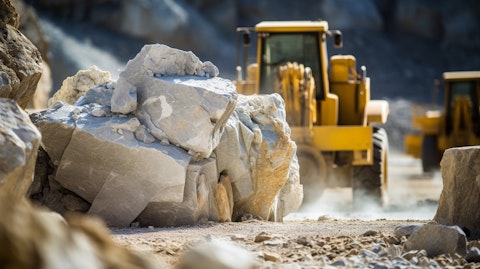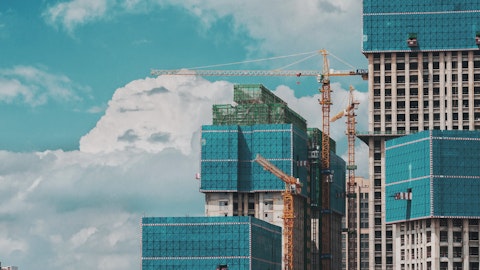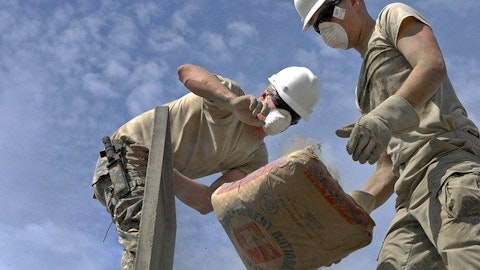Eagle Materials Inc. (NYSE:EXP) Q2 2024 Earnings Call Transcript October 26, 2023
Eagle Materials Inc. beats earnings expectations. Reported EPS is $4.28, expectations were $4.18.
Operator: Good day, everyone, and welcome to Eagle Materials Second Quarter of Fiscal 2024 Earnings Conference Call. This call is being recorded. At this time, I would like to turn the call over to Eagle’s President and Chief Executive Officer, Mr. Michael Haack. Mr. Haack, please go ahead, sir.
Michael Haack: Thank you, MJ. Good morning. Welcome to Eagle Materials conference call for our second quarter of fiscal year 2024. This is Michael Haack. Joining me today are Craig Kesler, our Chief Financial Officer; and Alex Haddock, Vice President of Investor Relations, Strategy and Corporate Development. There will be a slide presentation made in connection with this call. To access it, please go to eaglematerials.com and click on the link to the webcast. While you’re accessing the slides, please note that the first slide covers our cautionary disclosure regarding forward-looking statements made during this call. These statements are subject to risks and uncertainties that could cause results to differ from those discussed during the call.
For further information, please refer to this disclosure, which is also included at the end of our press release. Let me start off by saying that I’m excited to highlight another quarter of record operating and financial performance for Eagle Materials. In the second quarter of fiscal 2024, Eagle generated record revenue of $622 million, up 3%. Eagle expanded gross margins to 33.6%, up 150 basis points, and we achieved record net earnings per diluted share of $4.26, up 15%. A key reason for our superior margin performance is our commitment to our long-term sustainability of our plants, our businesses and our employees. On the employee front, I want to highlight an event that we conducted this past quarter, one that I always look forward to attending and participating in.
Our Seventh Annual Health, Safety and Environment Conference. This conference brings together our operations and HSE leaders from across all of Eagle. We have an open and honest discussion about where Eagle is currently and where we will be going with regards to HSE. From the focus and dedication of our people, Eagle has been able to continue to be an industry leader in keeping our employees safe as measured by our total recordable incident rate, reduce emissions through our focused implementation of PLC cement, reduce water usage through the redesign of our systems to ensure that they are closed loop and focus our efforts through best practice sharing and leading indicators to eliminate more serious injuries as demonstrated in our lost time injury rate.
I’ll now turn to more specifics on our operational and financial performance for this quarter, starting with the Heavy Materials businesses. Revenue increased 10% versus the prior year second quarter. Within our footprint, public highway and infrastructure awards continue to outpace the national average. Similarly, announced manufacturing construction projects of semiconductors, EV batteries, clean energy and heavy industrial projects have been benefiting the markets we serve. These announced projects totaled almost $500 billion nationwide since 2021. On the supply side, U.S. manufactured cement supply continues to be outpaced by demand. Total capacity has fallen since 2010 when further regulations were enacted known as niche, making new plant construction and capacity expansion challenging.
This creates the ingredients for a strong pricing environment. Thus, we implemented a second round of cement price increases in early July across half our markets and we have begun announcing the next round of increases for January of next year. This quarter, we also made meaningful progress in our conversion to Portland Limestone Cement, or PLC, surpassing 60% across our system. PLC makes our clinker go further and it is an important lever at our disposal for lowering the carbon intensity of our footprint. So we are excited about the opportunities PLC provides us. I’d be remiss if I did not add a little color around Texas Lehigh JV operation since it was mentioned in the last quarterly earnings call. I’m happy to say that we have made substantial progress on our [Killian] system and the plant is performing much better.
We still recognize that there is some more work to do, but I’m very pleased with the progress to date. In regards to the mid- and longer-term outlook for cement, concrete and aggregates, we have multiyear visibility into demand and the volume picture for cement remains robust across our end markets. Both public and private nonresidential construction, particularly within manufacturing projects continue to see strong spending. With the layering of federal infrastructure dollars, there is a meaningful runway for construction projects for years to come. There is often a long tail of demand from these projects as well as communities and other local infrastructure must be built out. Moving to the supply side outlook for the heavy side of our business.
We have very stringent permitting requirements in our industry. Because of this, we do not perceive any significant new plant builds or expansions in our markets that would materially change the supply picture. Since we are so constrained on manufacturing capacity, the sold-out markets around the coastal areas will have to turn to imported cement in order to meet the demand. To this extent, we have continued the integration of our recently acquired cement import terminal in Northern California to supplement our supply chain on the West Coast. Our manufactured cement footprint is made up of U.S. Heartland network that will remain largely insulated from imports given the high delivered cost to our markets. Because of these dynamics, we are optimistic about our short, mid- and long-term outlook for our heavy side businesses.

Now let me turn to our quarterly performance on the light side. For Gypsum Wallboard, sales volume declined 6%, while the average Gypsum Wallboard net sales price was flat with the prior year. It has been encouraging to see shipments, orders and pricing maintain their resiliency to date. Since housing is the most critical end market for us, we recognize the rise in interest rates and unclear path of consumer spending, may mean the environment sees choppy in the short term. Looking at the mid- and long-term demand outlook for Gypsum Wallboard business, we operate in markets in the Sunbelt and the South. In this market, single-family housing starts have held up relatively well. Similarly, single-family permits in the South coincided with homebuilder orders, given the limited supply of existing homes for sale should translate in the wallboard consumption in 2024.
Looking longer term, we see the structural underbuilt of housing in the U.S. getting worse before it gets better as rate lock-ins keep people in their current homes for longer, creating a tailwind for our businesses as new homes are built for existing homes undergo repair and remodel projects. With regard to the mid- and long-term supply outlook for our light side businesses, we have spoken many times of the effect of the lack of synthetic gypsum is having on the ability to add capacity to the industry. Let me provide an example. Looking at the prior 2 cycles in 1995 through 2000 and 2000 through 2008, represented 2 significant housing demand cycles in the U.S. In both those periods, the wallboard industry added significant new capacity through the cycle and beyond the demand peak.
This cycle has played out much differently. The industry has added no new capacity in over a decade even as pricing has reached record levels. This is indicative of the effect of raw material shortages are having on the broader industry. It needs to be noted that about half the industry supply is designed to utilize synthetic gypsum, because of this, the effective economic viability of the industry capacity is likely lower than nameplate figures imply. Eagle Materials benefits from the surety of raw material supply for all of our wallboard plants insulating us from the cost curve and the capacity pressures facing much of the wallboard industry. In fact, the demand-supply dynamics benefiting our Wallboard businesses resemble many of the qualities that make our cement and aggregates business is so attractive as well.
Closing out on our business performance through the first half of our fiscal year, I’d like to mention how well we continue to execute our capital allocation playbook. Eagle Materials cash flow generation is a key reason why the business is so attractive through cycles. Given our businesses are in a cyclical industries, we focus on cycle management, and on maintaining financial flexibility to create long-term value for our shareholders. Our priorities remain the same: to continue to grow our businesses and improve our low-cost competitive positions through acquisitions and organic investments that meet our strict strategic and financial return criteria. And when those opportunities don’t materialize, we use our share repurchase program to return cash to shareholders in a meaningful way.
Last quarter, we returned $86 million of cash to shareholders through share repurchases and dividends. We also used our strong cash flow to strengthen our balance sheet, our leverage ratio ended the quarter at 1.3x. With that, I’ll turn it over to Craig to go through our financial results in more detail.
Craig Kesler: Thank you, Michael. Second quarter revenue was a record $622 million, an increase of 3% from the prior year. The increase reflects higher cement sales prices and contribution from the recently acquired cement import terminal in Stockton, California, partially offset by lower wallboard and paperboard sales volume. Excluding the Stockton acquisition, revenue was up 1%. Again, this past quarter, we generated record earnings per share. Second quarter earnings per share was $4.26, a 15% increase from the prior year. The increase was driven by higher earnings at a 5% reduction in fully diluted shares due to our share buyback program. Turning now to our segment performance, highlight on the next slide. In our Heavy Materials sector, which includes our Cement and Concrete and Aggregates segments, revenue increased 10%, driven primarily by the increase in cement sales prices implemented earlier this year, and the contribution from the recently acquired cement import terminal in Northern California.
Operating earnings were up 19%, primarily because of increased cement prices. Given the strong market conditions that Michael discussed, we implemented a second round of cement price increases in early July, and our average cement price increased approximately $5 per ton or 3% sequentially. We’ve also recently announced cement price increases in most of our markets effective January 1, 2024. Moving to the Light Materials sector on the next slide. Revenue in our Light Materials sector decreased 8%, reflecting lower wallboard and recycled paperboard sales volume, while wallboard sales prices were flat. Operating earnings in the sector declined 2% to $93 million, reflecting lower wallboard sales volume, partially offset by reduced input costs, primarily for recycled fiber and energy.
Looking now at our cash flow. We continue to generate strong cash flow and allocate capital in a disciplined way. During the first 6 months of our fiscal year, operating cash flow improved 4% to $313 million, while capital spending increased to $66 million, and we acquired the cement import terminal in Stockton for $55 million. We also repurchased a total of 917,000 shares or 2.5% of our outstanding for $151 million in addition to paying our quarterly dividends, returning a total of $169 million to shareholders during the first half of our fiscal year. We have approximately 6.8 million shares remaining under our current repurchase authorization. Finally, we used our strong cash flow to strengthen our balance sheet. Let’s look at our capital structure.
At September 30, 2023, our net debt-to-cap ratio was 45%, and our net debt-to-EBITDA leverage ratio was 1.3x. We ended the quarter with $47 million of cash on hand. Total committed liquidity at the end of the quarter was approximately $627 million and we have no meaningful near-term debt maturities, giving us substantial financial flexibility. Thank you for attending today’s call. MJ, we’re ready to move to the question-and-answer session.
See also 20 Saddest Cities in the World and Can AI Imitate the 50 Greatest Classical Music Composers of All Time?.
Q&A Session
Follow Eagle Materials Inc (NYSE:EXP)
Follow Eagle Materials Inc (NYSE:EXP)
Operator: [Operator Instructions] Today’s first question comes from Trey Grooms with Stephens.
Trey Grooms : So we’ve seen volume down in wallboard now for, I guess, the last 2 quarters and no surprise, and I think it’s actually holding in better than most would have thought. And Michael, you gave a little color on the demand outlook there, but understandably with the backdrop of higher rates, this clearly creates more uncertainty, at least around the residential backdrop here. But given what we’ve seen from starts and completions on the residential side. To the extent that you can talk about it, how are you thinking about the wallboard volume outlook in the near term? And then at what point do you expect that we could start to see some stabilization there?
Craig Kesler: Yes, Trey, you bring up a lot of interesting points. Look, the higher interest rate environment it will navigate through. And there’s factors on the other side, most notably, a shortage of homes in many markets across the U.S. of existing homes which is a very different environment than we’ve seen in prior cycles. It’s also important to note where we operate in the southern part of the U.S. where activity has been more robust than other parts of the country. And I think that’s our core market. And look, we continue to have homeowners requiring to live somewhere. So there are a lot of factors and — we’ve seen homebuilder orders improved this quarter and again last quarter as well. So it’s hard to predict right now, but we think we’re positioned pretty well.
Trey Grooms: Okay. And I guess with that, just kind of sticking with the demand picture. On the cement side, granted, there’s maybe some more — or quite a bit more visibility there into the demand picture, which sounds like it’s still pretty good. But as we look into maybe the calendar ’24, with this kind of increased uncertainty again that’s created by the rate situation. Is it your expectation that we should continue to stay in what is kind of a sold-out position or at least nearly sold-out position as we kind of look over the foreseeable future?
Craig Kesler : Yes. As opposed to the wallboard industry, which is more residentially oriented, cement and aggregates demand is more driven by infrastructure spending. And obviously, with the multiyear highway bill that those funds are starting to really benefit of highway awards and that activity, that should more than offset the residential impact on the heavy side. Not to mention, and Michael pointed to them out, several large kind of manufacturing/industrial type projects for battery plants, semiconductor facilities, that activity is at a multi-decade high. So that’s what gives us some confidence around the outlook for the heavy side demand not just for ’24, but beyond that, given those projects are multiyear in nature.
Trey Grooms: Okay. And I’ve got to sneak 1 more in here, if I could. You mentioned you went out with a cement pricing announcement for early January. Any additional color you could give us on maybe magnitude or maybe how widespread these announcements are?
Craig Kesler: Yes. It’s across most of our markets, January 1, still evaluating all of our markets, but the announcements have ranged between $10 to $15 a ton.
Trey Grooms : Perfect. I’ll turn it over.
Operator: The next question comes from Stanley Elliott with Stifel.
Stanley Elliott: Congratulations. I was just curious, when you talk about the wallboard pricing has been so resilient. Is there a way to quantify kind of the differences that you’re seeing in the East and the West? And you spoke a little bit about some of the synthetic piece. I was curious as to what that might be having an impact on it.



